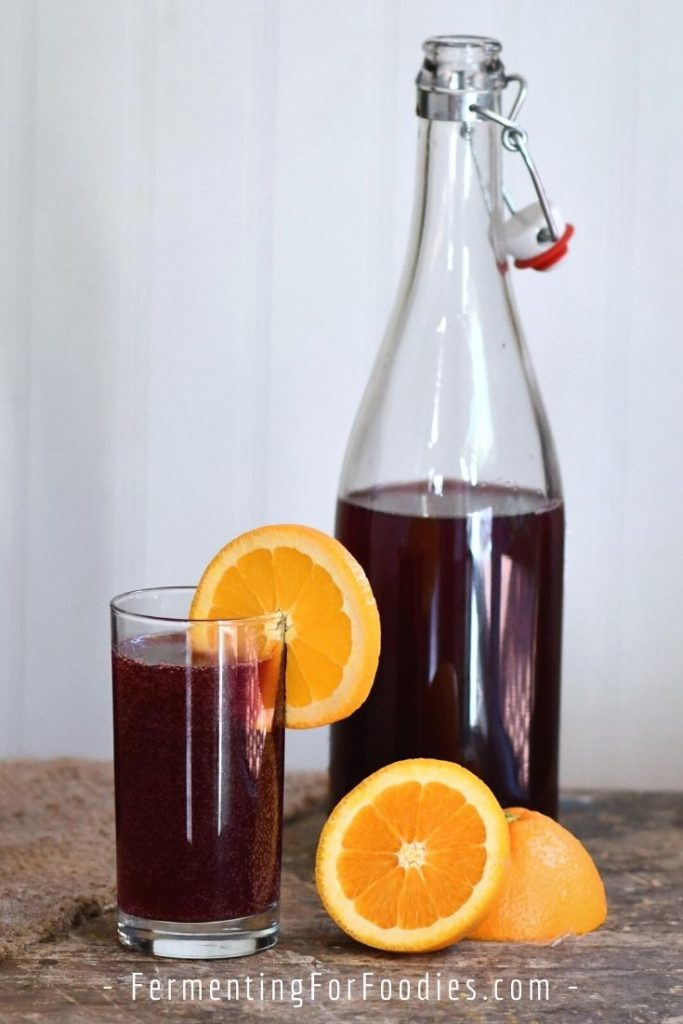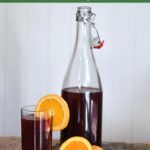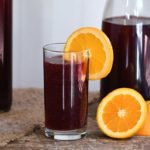Cranberry ginger ale is a winter tradition in Canada. It is a warming combination of spicy, sour, and sweet, that is bright red and delicious.

The commercial version comes in 2 L plastic pop bottles and is more sweet than spicy. In contrast, homemade cranberry ginger ale is made with the ginger bug for a flavorful and probiotic drink.
A full-flavored ginger ale
The best part about making your own ginger ale is that you can flavor it to suit your taste. Use a mix of cranberry and apple juice for a refined sugar-free and tart beverage. Mix it with sparkling water for a mild and bright drink.
Here are a few different fruits and spices that can be added to your cranberry ginger ale. So you can create your own unique blend.
- For spicy ginger ale, add 2 Tbsp of freshly grated ginger. This will float as it ferments, so be sure to strain before bottling.
- Use mulling spices for a mulled cranberry cider flavor. Add 1 stick of cinnamon, 3 whole cloves, and 3 allspice berries per batch.
- Orange and lemon zest are my favorite flavor additions. Adding 1 Tbsp of zest gives this drink a fresh dimension.
- If cranberry isn’t your thing, here are other juicy ginger ale options.
Holiday cocktails
Ginger ale brewed with the ginger bug is not alcoholic. The probiotic yeasts and bacteria are not meant to brew an alcoholic beverage.
However, cranberry ginger ale is delicious for mixing winter holiday cocktails! Here are a few options:
- Use ginger ale as a highball mix. It’s delicious with vodka, whisky or rum.
- Make a Prosecco cocktail.
- Or a merry berry punch.
If you’re new to ginger bug, here’s how to brew a ginger bug soda:
Cranberry Ginger Ale
Homemade cranberry ginger ale is a sour, sweet, sparkling and spicy drink. Made with the ginger bug, it is a delicious and probiotic holiday tradition.
- Prep Time: 10 minutes
- Total Time: 10 minutes
- Yield: 4 cups 1x
- Category: Beverage
- Method: Fermented
- Cuisine: Canadian
- Diet: Gluten Free
Ingredients
- 2 cups of water (chlorine-free)
- 1 1/2 cups unsweetened cranberry juice
- 6 Tbsp sugar
- 1/4 cup ginger bug starter
- Spices, fruit, and other flavor additions (see section above for suggestions)
Instructions
- Mix the water, juice, and sugar in a 1-quart (1 L) mason jar. Stir until the sugar is dissolved. Stir in the ginger bug, and any additional flavors.
- Cover the jar with a piece of cloth or a coffee filter held in place with a rubber band or metal ring. Place the jar somewhere warm to ferment for 3 to 5 days. Give it a good stir each day.
- Once it is bubbling, strain the liquid into a swing-top bottle or plastic pop bottle. Allow it to ferment at room temperature for 3 to 5 more days to build up the carbonation. Taste a little bit, and add more sugar if needed. Most of the initial sugar will have been used up by the ginger bug, so it may be quite tart.
- Once the cranberry ginger ale is fizzy, store it in the refrigerator and enjoy! Ginger bug sodas are best if consumed within four weeks of bottling.
Notes
- To make brewed ginger ale, you need to catch a ginger bug starter. It usually only takes 2 to 5 days as ginger (particularly organic ginger) naturally ferments. Once you have the starter, you can brew all sorts of different flavors of ginger beer.
- For a refined sugar-free option, use apple juice instead of water. It will provide enough natural sugars to feed the ginger bug. You will need to add 1 Tbsp of white sugar when bottling to help with the carbonation.


Hi!
I think that you may mean “Cranberry Cocktail” instead of “Cranberry Juice” in the recipe. I made this recipe with 1 3/4c apple cider and 1 3/4c cranberry juice (no sugar or other juices added) and the mixture was still acidic enough to kill my yeast. Cranberry cocktail is what you typically buy to drink (think Ocean Spray). Cranberry juice is very sour and not drinkable on its own.
Your recipe made a great juice to mix with some sparkling water, but I did not get fermentation. Let me know if you know how how to dilute the cranberry juice to make it usable!
Thanks,
Alex
Hum… I used a local cranberry juice (not cocktail) mixed with apple (the bottle on the right). It didn’t carbonate as much as when I add sugar instead of apple juice (the bottle on the left). That’s because fruit juice is more fructose and ginger bug feeds on sucrose (sugar). So it needs a bit of sugar to properly carbonate.
I wonder if it’s because the producer is actually diluting the juice with water? I assumed it was 100% juice (from this brand:https://triplejimsjuice.com/) and didn’t think the acidity would kill the ginger bug. I make this pretty much every December, so I’ll try with a different brand of juice this year. Another thing to be careful of is added preservatives which would prevent fermentation. Unfortunately in certain places (like the US and Canada) preservatives don’t need to be labelled in the ingredient list unless they are at really high levels. Look for preservative-free on the label, which does come with government protections (for those with allergies.)
As for how to fix your current batch… you could try diluting with water and a bit of sugar. Maybe dissolve 3 tbsp of sugar in 2 cups of water and see if that helps kick start the ferment by feeding the ginger bug. It will be sweet until the ginger bug has had time to eat up the sugar. Good luck!
I want to use fresh cranberries put through a juicer or vitamix instead of store bought cranberry juice… any advice welcome
That would work! The cranberries will likely already have cultures on their skin. So I recommend pasteurizing the juice by bringing it to a boil for 5 minutes (to kill any yeast/bacteria/mold). Then let it cool before adding in the ginger bug starter. Enjoy!
Thanks for the recipe.